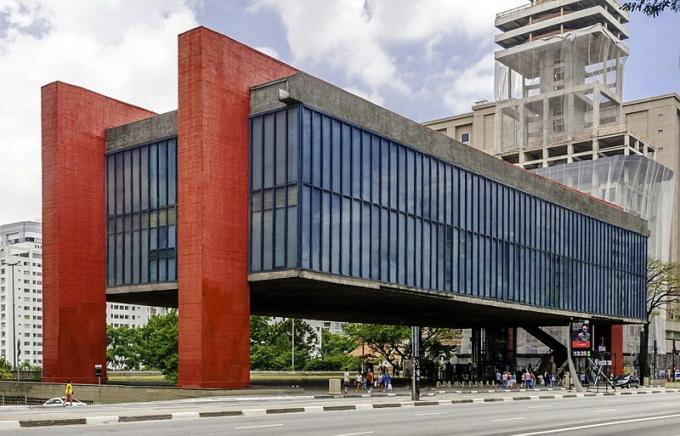Modern architecture is a style that emerged in the 20th century as a movement in opposition to the architecture that had been done until then - more elaborate and with an excess of ornaments. With the creation of Bauhaus School, by initiative of the German architect Walter Gropius, this new phase of architecture begins.
In Brazil, modernist architecture began in the first decades of the 20th century and reached its peak in the 1950s, having as its main exponents Oscar Niemeyer and Lucius Costa.
The modern style in architecture favors the simple and the social role of the works. Modernist constructions reject architectures with decorative and ornamental elements and employ geometric shapes and simple lines.
In modernist architecture "less is more" and "form follows function".
 Palácio do Planalto, designed by Oscar Niemeyer, one of the most iconic works of modern Brazilian architecture.
Palácio do Planalto, designed by Oscar Niemeyer, one of the most iconic works of modern Brazilian architecture.
The materials and technological innovations provided by Industrial Revolution, that was ongoing at that time, influenced the constructions. Concrete, steel and iron, materials that began to be produced in scale, were widely used in modernist works.
Modern architecture is part of the context of modernist movement, which, in addition to architecture, influenced other cultural aspects, such as literature, poetry, dance and sculpture.
Learn more about architecture.
Characteristics of modern architecture
- Buildings are functional, planned according to how people will use them.
- There is an integration of architecture with nature and the surrounding landscape.
- Decorative, ornamental and superfluous elements are rejected.
- Defined lines and geometric shapes are used.
- Buildings are clean, economical and useful.
- Finishes in exposed concrete at the expense of plastering and painting.
- Use of pillars (type of column) to free up space on the ground floor of buildings.
Summary of the history of modern architecture
Modern architecture has its origins in Europe, in the context of Revolution Industrial and technological development. It is at this moment that new techniques are used to build skyscrapers and the Eiffel Tower.
The starting point of this architectural movement was the Bauhaus school in Germany, where buildings were designed with a focus on functionality and simplicity of form.
This school was closed in 1933 by Hitler, in the context of the rise of Nazism. The artists from this school, however, moved to other countries and continued their work in architecture.
Some of the most famous foreign modernist architects are: Frank Loyd Wright, Mies van der Rohe and Le Corbusier.
Modern architecture in Brazil
One of the precursors of modernist architecture in Brazil was the Russian George Warchavchik. His house, built in Vila Mariana in São Paulo, in 1927, is considered the first modernist work in the country.
Warchavchik was hired as a professor at the Rio de Janeiro School of Fine Arts (ENBA), where he worked with Lúcio Costa, who was the institution's director in 1930 and 1931.
One of the great milestones for modern architecture in Brazil was the construction of the Ministry of Education and Health, whose technical consultant was the renowned Le Corbusier and was coordinated by Lúcio Costa. Among the architects that formed the team were Oscar Niemeyer and Afonso Eduardo Reidy.
know more about Modern Art.
 Facade of the Ministry of Education and Health, in Rio de Janeiro.
Facade of the Ministry of Education and Health, in Rio de Janeiro.
After participating in this construction and other successful projects, Oscar Niemeyer was invited by the then President of the Republic, Juscelino Kubitschek, to design the main buildings in Brasília.
The construction of Brasília was entirely inspired by modernist ideals and its urban design was in charge of Lúcio Costa.
Difference between modern architecture and contemporary architecture
Modern and contemporary architecture, despite having similarities, are different movements. Modern architecture had its beginnings in the beginning of the 20th century and prevailed until the mid-1950s. Contemporary architecture dates from the late 1980s and remains today.
Contemporary architecture brings elements of modern architecture, such as minimalism and rationalism, but is concerned with other issues, such as environmental comfort and the sustainability of buildings.
From this movement, there is a great concern with the use of recyclable, natural and non-toxic materials and the valorization of natural light inside buildings.
See also the meaning of greek architecture, Renaissance architecture and Gothic architecture.
Leading modernist architects and their works
Find out who were the main exponents of modern architecture in Brazil and in the world:
Le Corbusier
Considered one of the most important architects of the 20th century, the Frenchman Le Corbusier was responsible for the Unite d'Housing, housing built after the end of World War II.
 Housing unit in Marseille, France.
Housing unit in Marseille, France.
It was Corbusier who proposed, in 1926, the 5 points of modern architecture, employed in most modernist works:
- Free plant: buildings without walls and partitions, so that the renovations would not cause damage to the structures. If it was necessary to build walls, they can be made of plaster or any other material, providing more flexibility in the use of space.
- Free facade: the free facade is a consequence of the free plan. As the walls are not part of the structure, there is no need to match the structure with the façade.
- Tape windows: windows are long openings that often cut the length of the entire building. Allow more natural light and panoramic views from the outside.
- Pilots: Pilotis are the steel pipes that lift structures. Corbusier defended this gap to allow people to pass under the buildings, that is, that they do not become physical barriers to the coming and going.
- Garden terrace: use of the terraces of the houses as gardens and living spaces. The idea was to give functionality to a part of the buildings that is usually unusable.
Frank Loyd Wright
Wrigth is an American architect who sought to harmonize his buildings with nature. His most famous work, the Cascade House, it was built in an integrated way to the water course of a waterfall and to the stones and vegetation of the land.
 Cascade House, Pennsylvania, United States.
Cascade House, Pennsylvania, United States.
Afonso Eduardo Reidy
Reidy was born in France, but grew up and lived in Rio de Janeiro. Along with Oscar Niemeyer and Lúcio Costa, she participated in the project for the Ministry of Education and Health. In addition, she was the architect responsible for building the Museum of Modern Art of Rio de Janeiro.
 Museum of Modern Art of Rio de Janeiro.
Museum of Modern Art of Rio de Janeiro.
Lina Bo Bardi
The Italian-Brazilian architect Lina Bo Bardi came to Brazil in 1946 and became a naturalized Brazilian in 1951. Bardi was responsible for the project of the São Paulo Museum of Art (MASP). The museum has a span with a ceiling height of 8 meters and 74 meters in length - the work with the largest free span in the world at the time.

Another famous work by Bardi is the Glass House, which was built in the Morumbi neighborhood, in São Paulo, to be his residence. Built in the middle of the Atlantic Forest, it is surrounded by glass and is structured on stilts - steel tubes that elevate the structure.
 Glass House in São Paulo
Glass House in São Paulo
What was modernism?
Modernism was an artistic and cultural movement that sought to break with the aesthetic traditionalism that had prevailed until then. This movement dates back to the beginning of the 20th century and is marked by the 1922 Modern Art Week.
This event took place at the Municipal Theater of São Paulo and featured musical performances, poetry recitations, exhibitions of works of art and sculptures.
Understand what the Modernism and yours features.


